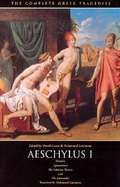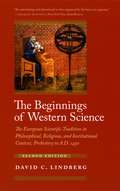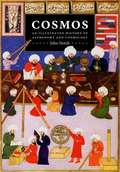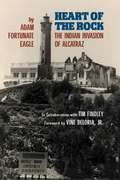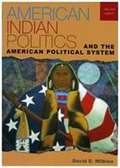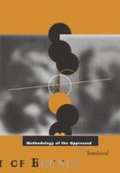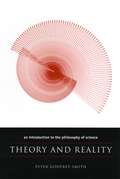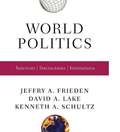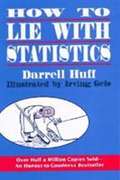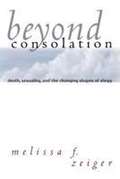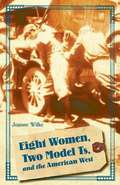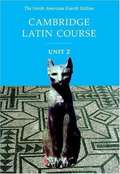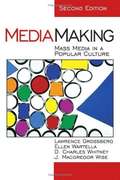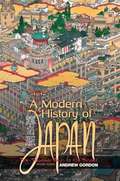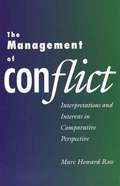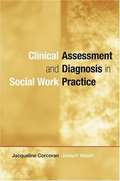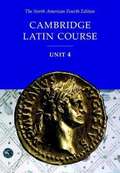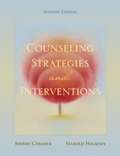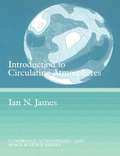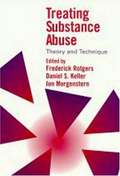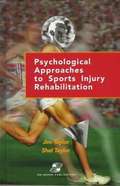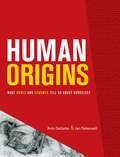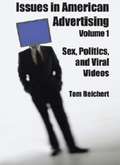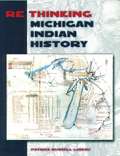- Table View
- List View
Aeschylus I: Agamemnon, The Libation Bearers, The Eumenides (The Complete Greek Tragedies #1)
by Aeschylus David Grene Richmond Lattimore"These authoritative translations consign all other complete collections to the wastebasket."--Robert Brustein, The New Republic. "This is it. No qualifications. Go out and buy it everybody."--Kenneth Rexroth, The Nation. "The translations deliberately avoid the highly wrought and affectedly poetic; their idiom is contemporary.... They have life and speed and suppleness of phrase."--Times Education Supplement. "These translations belong to our time. A keen poetic sensibility repeatedly quickens them; and without this inner fire the most academically flawless rendering is dead."--Warren D. Anderson, American Oxonian. "The critical commentaries and the versions themselves... are fresh, unpretentious, above all, functional."--Commonwealth. "Grene is one of the great translators."--Conor Cruise O'Brien, London Sunday Times. "Richmond Lattimore is that rara avis in our age, the classical scholar who is at the same time an accomplished poet."--Dudley Fitts, New York Times Book Review.
The Beginnings of Western Science: The European Scientific Tradition in Philosophical, Religious, and Institutional Context, Prehistory to A.D. 1450 (2nd edition)
by David C. LindbergWhen it was first published in 1992, The Beginnings of Western Science was lauded as the first successful attempt ever to present a unified account of both ancient and medieval science in a single volume. Chronicling the development of scientific ideas, practices, and institutions from pre-Socratic Greek philosophy to late-Medieval scholasticism, David C. Lindberg surveyed all the most important themes in the history of science, including developments in cosmology, astronomy, mechanics, optics, alchemy, natural history, and medicine. In addition, he offered an illuminating account of the transmission of Greek science to medieval Islam and subsequently to medieval Europe. Beginnings of Western Science was, and remains, a landmark in the history of science, shaping the way students and scholars understand these critically formative periods of scientific development. It reemerges here in a second edition that includes revisions on nearly every page, as well as several sections that have been completely rewritten. For example, the section on Islamic science has been thoroughly retooled to reveal the magnitude and sophistication of medieval Muslim scientific achievement. And the book now reflects a sharper awareness of the importance of Mesopotamian science for the development of Greek astronomy. In all, the second edition of The Beginnings of Western Science captures the current state of our understanding of more than two millennia of science and promises to continue to inspire both students and general readers.
Cosmos: An Illustrated History of Astronomy and Cosmology
by John D. NorthFor millennia humans have studied the skies to help them grow crops, navigate the seas, and earn favor from their gods. We still look to the stars today for answers to fundamental questions: How did the universe begin? Will it end, and if so, how? What is our place within it? John North has been examining such questions for decades. In Cosmos, he offers a sweeping historical survey of the two sciences that help define our place in the universe: astronomy and cosmology. Organizing his history chronologically, North begins by examining Paleolithic cave drawings that clearly chart the phases of the moon. He then investigates scientific practices in the early civilizations of Egypt, Greece, China, and the Americas (among others), whose inhabitants developed sophisticated methods to record the movements of the planets and stars. Trade routes and religious movements, North notes, brought these ancient styles of scientific thinking to the attention of later astronomers, whose own theories-- such as Copernicus' planetary theory-- led to the Scientific Revolution. The work of master astronomers, including Ptolemy, Galileo, Kepler, and Newton, is described in detail, as are modern-day developments in astrophysics, such as the advent of radio astronomy, the brilliant innovations of Einstein, and the many recent discoveries brought about with the help of the Hubble telescope. This new edition brings North's seminal book right up to the present day, as North takes a closer look at last year's reclassification of Pluto as a "dwarf" planet and gives a thorough overview of current research. With more than two hundred illustrations and a comprehensive bibliography, Cosmos is the definitive history of astronomy and cosmology. It is sure to find an eager audience among historians of science and astronomers alike.
Heart of the Rock: The Indian Invasion of Alcatraz
by Adam Fortunate Eagle Tim FindleyAn intimate memoir of the two-year invasion and occupation of Alcatraz by American Indians and of the events leading up to it. Traces and cultural agonies and federal pressures on American Indians "relocated" to urban areas that led to the invasion of Alcatraz.
American Indian Politics and the American Political System (2nd edition)
by David E. WilkinsIn this college textbook, Wilkins (American Indian studies, political science, law, and American studies, U. of Minnesota) considers the relationship of American Indian governments to the American political system with emphasis on the sovereignty of tribal nations. He analyzes the status of indigenous peoples and their citizenship, the concept of tribal sovereignty and the issues policymakers have, and their relationship with the government's branches. He provides an overview of federal Indian policy in history, descriptions of tribal governments, political economy and gaming, participation, interest-group activities and social activism, and the effect of the media. This edition integrates new census data; discussions of changes to elections, US House and Senate personnel, and legislation on Indian rights and the state-tribal relationship; and information on George W. Bush's terms in office. Annotation ©2006 Book News, Inc., Portland, OR (booknews.com)
Methodology of the Oppressed
by Chela SandovalIn a work with far-reaching implications, Chela Sandoval does no less than revise the genealogy of theory over the past thirty years, inserting what she terms "U.S. Third World feminism" into the narrative in a way that thoroughly alters our perspective on contemporary culture and subjectivity. What Sandoval has identified is a language, a rhetoric of resistance to postmodern cultural conditions. U.S liberation movements of the post-World War II era generated specific modes of oppositional consciousness. Out of these emerged a new activity of consciousness and language Sandoval calls the "methodology of the oppressed". This methodology -- born of the strains of the cultural and identity struggles that currently mark global exchange -- holds out the possibility of a new historical moment, a new citizen-subject, and a new form of alliance consciousness and politics. Utilizing semiotics and U.S. Third World feminist criticism, Sandoval demonstrates how this methodology mobilizes love as a category of critical analysis. Rendering this approach in all its specifics, Methodology of the Oppressed gives rise to an alternative mode of criticism opening new perspectives on a theoretical, literary, aesthetic, social movement, or psychic expression.
Theory and Reality: An Introduction to the Philosophy of Science
by Peter Godfrey-SmithHow does science work? Does it tell us what the world is "really" like? What makes it different from other ways of understanding the universe? In Theory and Reality, Peter Godfrey-Smith addresses these questions by taking the reader on a grand tour of one hundred years of debate about science. The result is a completely accessible introduction to the main themes of the philosophy of science. Intended for undergraduates and general readers with no prior background in philosophy, Theory and Reality covers logical positivism; the problems of induction and confirmation; Karl Popper's theory of science; Thomas Kuhn and "scientific revolutions"; the views of Imre Lakatos, Larry Laudan, and Paul Feyerabend; and challenges to the field from sociology of science, feminism, and science studies. The book then looks in more detail at some specific problems and theories, including scientific realism, the theory-ladeness of observation, scientific explanation, and Bayesianism. Finally, Godfrey-Smith defends a form of philosophical naturalism as the best way to solve the main problems in the field. Throughout the text he points out connections between philosophical debates and wider discussions about science in recent decades, such as the infamous "science wars." Examples and asides engage the beginning student; a glossary of terms explains key concepts; and suggestions for further reading are included at the end of each chapter. However, this is a textbook that doesn't feel like a textbook because it captures the historical drama of changes in how science has been conceived over the last one hundred years. Like no other text in this field, Theory and Reality combines a survey of recent history of the philosophy of science with current key debates in language that any beginning scholar or critical reader can follow.
World Politics
by Jeffry A. Frieden David A. Lake Kenneth A. SchultzWhy are there wars? Why do countries have a hard time cooperating to prevent genocides or global environmental problems? Why are some countries rich while others are poor? Organized around the puzzles that draw scholars and students alike to the study of world politics, this book gives students the tools they need to think analytically about compelling questions like these. World Politics introduces a contemporary analytical framework based on interests, interactions, and institutions. Drawing extensively on recent research, the authors use this flexible framework throughout the text to get students thinking like political scientists as they explore the major topics in international relations.
How to Lie with Statistics
by Darrell Huff Irving GeisA 1954 classic that continues to dispel false beliefs and inform the statistically naive. Huff's direct and witty style exposes how advertisers, government and the media mislead their audiences through the misuse of statistics. Huff then explains how the reader can see through the smoke and mirrors to get to the real meaning-- if any-- of what is presented. Annotation c. by Book News, Inc., Portland, Or.
Beyond Consolation: Death, Sexuality, and the Changing Shapes of Elegy
by Melissa F. ZeigerUsing as her starting point the story of Orpheus and Eurydice, Melissa F. Zeiger examines modern transformations of poetic elegy, particularly as they reflect historical changes in the politics of gender and sexuality.
Eight Women, Two Model Ts, and the American West
by Joanne WilkeIn 1924 eight young women drove across the American West in two Model T Fords. In nine weeks they traveled more than nine thousand unpaved miles on an extended car-camping trip through six national parks, "without a man or a gun along." It was the era of the flapper, but this book tells the story of a group of farm girls who met while attending Iowa's Teacher's College and who shared a "yen to see some things." A blend of oral and written history, adventure, memoir, and just plain heartfelt living, Eight Women is a story of ordinary people doing extraordinary things. Weaving together a granddaughter's essays with family stories and anecdotes from the 1924 trip, the book portrays four generations of women extending from nineteenth-century Norway to present-day Iowa-- and sets them loose across the western United States where the perils and practicalities of automotive travel reaffirm family connections while also celebrating individual freedom.
Cambridge Latin Course, Unit 2
by Stephanie Pope Patricia E. Bell Stan Farrow Richard M. Popeck Anne Shaw Peter Kesteven Joy Mellor Leslie JonesThe Fourth Edition Cambridge Latin Course is an introductory program organized into four well-integrated units. Cambridge's proven approach includes a stimulating continuous story line, interwoven grammatical development and cultural information, supportive illustrations and photographs, and a complete Language Information section. Reading is the heart of the Cambridge Latin Course, and all the elements of the program - illustrations, vocabulary, grammar and syntax, cultural contexts and references, activities - are carefully introduced and arranged to provide students with the skills they need to read with comprehension and enjoyment from the very first page. Student Book The most effective tool for students and teachers of Latin! A continuous and motivating story line captures and holds students' imagination. . . The logical pattern of each Stage and careful integration among Stages and Units train students to read Latin with ease and to understand the culture of the Romans. . . Clear language explanations and examples and ample practice insure student mastery of Latin. . . And rich illustrations bring the works and experiences of the Romans to life.
Mediamaking: Mass Media in a Popular Culture
by Lawrence Grossberg Ellen Wartella D. Charles Whitney J. Macgregor WiseFor both undergraduates and graduate students, this textbook explores the context, history, organizations, and economics of mass media. Grossberg (communication studies and cultural studies, U. of North Carolina at Chapel Hill) et al. consider the media in terms of meaning and ideology, its power in the creation of identity, and with consumers, behavior, politics, and the public. They do not organize the text around types, such as newspaper, broadcasting, and radio, but rather take a theoretical look at the media in the context of society. The second edition has new statistics and examples, in addition to a new author who brings topics of cyberculture, globalization, and alternatives to the forefront. Annotation ©2006 Book News, Inc., Portland, OR (booknews.com)
A Modern History of Japan: From Tokugawa Times to the Present (2nd edition)
by Andrew GordonGordon (history and Japanese studies, Harvard U.) begins his history in about 1800, looking at how particularly the industrial revolution had changed the balance of global economic and military power, and the pressures that caused the Tokugawa military lords to fall from power. Annotation (c)2003 Book News, Inc., Portland, OR (booknews.com)
The Management of Conflict: Interpretations and Interests in Comparative Perspective
by Marc Howard RossTopics include: Political anthropology, Conflict management in cross-cultural studies, and Ethnopsychology.
Clinical Assessment and Diagnosis in Social Work Practice
by Jacqueline Corcoran Joseph WalshThis tightly focused textbook will help clinical social workers not only develop competence in the Diagnostic and Statistical Manual (DSM-IV-TR) system of diagnosis, it will also assist them to stay attuned during client assessment to social work values and principles -- a focus on client strengths, concern for the worth and dignity of individuals, appreciation of environmental influences on behavior, and a reliance on evidence-based approaches.
Cambridge Latin Course, Unit 4
by Patricia E. Bell Stan Farrow Richard M. Popeck Anne Shaw Peter Kesteven Joy Mellor Leslie Jones Stephanie M. PopeThe North American Cambridge Latin Course is a well-established four-part Latin program whose approach combines a stimulating, continuous storyline with grammatical development, work on derivatives, and cultural information. There is also a complete Language Information section, plus numerous color photographs illustrating life in the Roman world. The Course has now been fully revised and updated in the light of feedback from user schools, and includes the very best in new research. The Fourth Edition continues to offer teachers and students alike a stimulating, reading- based approach to the study of Latin.
Counseling Strategies and Interventions (7th edition)
by Sherry Cormier Harold HackneyEmphasizing the importance of interpersonal skills to counseling, this textbook contains ten chapters on topics such as recognizing communication patterns, managing the counseling session, responding to cognitive content, responding to affective content, conceptualizing issues and setting goals, interactive counseling strategies, and common challenges. The authors are affiliated with West Virginia University and Syracuse University. Annotation ©2004 Book News, Inc., Portland, OR (booknews.com)
Introduction to Circulating Atmospheres
by Alexander J. Dessler John T. Houghton Michael J. Rycroft Ian N. JamesThis book gives an account of the modern view of the global circulation of the atmosphere. It brings the observed nature of the circulation together with theories and simple models of the mechanisms which drive it. Early chapters concentrate on the classical view of the global circulation, on the processes which generate atmospheric motions and on the dynamical constraints which modify them. Later chapters develop more recent themes including low frequency variability and the circulations of other planetary atmospheres. The book will be of interest to advanced students and researchers who wish for an introduction to the subject before engaging with the original scientific literature. The book is copiously illustrated, and includes many results of diagnostic and modeling studies. Each chapter includes a set of problems and bibliographical notes.
Treating Substance Abuse: Theory and Technique
by Frederick Rotgers Daniel S. Keller Jon MorgensternDescribes five theories of substance abuse treatment and details how to translate each theory into actual practice. Material on 12-step, psychodynamic, behavioral, marital/family, and motivational approaches incorporates case examples, discussion of advantages and disadvantages of each approach, and treatment techniques. Includes a chapter on emerging pharmacological approaches. For advanced students in psychology, social work, and medicine, and for substance abuse counselors in training. Annotation c. by Book News, Inc., Portland, Or.
Psychological Approaches to Sports Injury Rehabilitation
by Jim Taylor Shel TaylorIn dedicating this guide for rehabilitation specialists, consultants J. Taylor and S. Taylor (U. of Connecticut Health Center, Farmington) refer to frustration and patience as well as to pain and expertise, recognizing that bouncing back from sidelining sports injuries entails mind as well as body. Augmented by celebrity soundbites, the authors detail the referral process for assessing psychological problems; mental influences on rehabilitation (motivation, anxiety, focus); facilitatitive techniques (imagery, using negative thinking positively, pain management, social support); return to the sport; and development of a psychological rehab program (with sample forms, program prescription summaries). Annotation c. by Book News, Inc., Portland, Or.
Comparing the States and Communities: Politics, Government, and Policy in the United States
by Normal Luttbeg Harvey TuckerBook on politics, government, and policy in the United States.
Human Origins: What Bones and Genomes Tell Us About Ourselves
by Rob Desalle Ian TattersallEver since the recognition of the Neanderthals as an archaic form of human in the mid-nineteenth century, the fossilized bones of extinct humans have been used by paleoanthropologists to explore human origins. These bones tell the story of how the earliest humans first emerged in Africa some 6 to 7 million years ago. The bones also reveal that as humans became anatomically and behaviorally more modern, they swept out of Africa in waves into Asia, Europe, and finally into the New World. Even as paleoanthropologists continued to make important discoveries, experts in genetics were looking at the human species from a very different angle. In 1953 James Watson and Francis Crick first envisioned the double helix structure of DNA, the basic building block of all life. In the 1970s it was shown that humans share 98.7 percent of their genes with the great apes--that in fact genetically we are more closely related to chimpanzees than chimpanzees are to gorillas. And most recently the entire human genome has been mapped--we now know where each of the genes are located on the DNA strands that make up our chromosomes. In Human Origins: What Bones and Genomes Tell Us about Ourselves, two of the worlds foremost scientists, geneticist Rob DeSalle and paleoanthropologist Ian Tattersall, show how research into the human genome confirms what fossil bones have told us about human origins. This unprecedented integration of the fossil and genomic records provides the most complete understanding possible of humanity's place in nature, its emergence from the rest of the living world, and the evolutionary processes that have molded human populations to be what they are today.
Issues in American Advertising: Media, Society, and a Changing World
by Tom ReichertEssays on issues in American advertising.
Rethinking Michigan Indian History
by Patrick Russell LebeauRethinking Michigan Indian History is a teaching tool that honors the Chippewa, Ottawa, and Potawatomi and the twelve federally recognized tribes of Michigan by recognizing their role and place in Michigan history-- exploring what most people know (or do not know) about them. Each lesson includes a background narrative, a set of hands-on, tactile activities, and provides easily understood and visual resources. Rethinking Michigan Indian History explores large issues of Indian stereotypes, the narrow focus on "great" Indian men, the lack of knowledge about treaties and treaty rights, and the role of maps to mislead or distort thinking about how history unfolds and the complexities of land ownership. The lesson exploring Indian stereotypes identifies their existence not only in U.S. consumer culture but also in K-12 classrooms. The goal, however, is not to rebuke the consumer for having bought Big Chief Sugar or the teacher for having young students construct one-dimensional canoes, paddles and Indians out of paper and glue but to use those activities as a demonstration of what most people know about Indians. From this point, a foundation of facts can begin to replace stereotypes in the learning process. Demonstrating further how popular influences can control knowledge, the lesson on "great" Indian men shows how the popular preference for biographies of famous Indian warriors, like Pontiac and Tecumseh or individual women, like Pocahontas and Sacagawea, narrows an understanding of Indians to symbolic representations and issues and ignores their ongoing culture. The lesson on Indian treaties and maps explains and visually shows the reason the Chippewa, Ottawa, and Potawatomi lived in Michigan in 1760 and live in Michigan today in roughly the same places. Treaties are explored in a manner understandable to fourth graders through adults.
